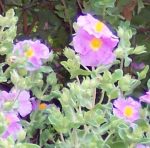 Also known as hoary rock rose and pink rock rose, this evergreen flowering shrub is a member of the Cistaceae family, a small group of shrubs and semi shrubs that do well in dry, sunny locations with poor soil. It is native to Mediterranean areas where it grows in scrub and in bushy places on rocks, dry hills and similar sites. The plants form a mound about 2-4′ tall by 2-3′ wide and have gray-green leaves with wavy edges. From late spring to summer 2″ wide pink or white flowers with 5 crepey petals and a mass of bright yellow stamens appear and attract butterflies and bees. Each flower lasts only a day but the plant has a long bloom time. Photo Credit: A Barra Wikipedia
Also known as hoary rock rose and pink rock rose, this evergreen flowering shrub is a member of the Cistaceae family, a small group of shrubs and semi shrubs that do well in dry, sunny locations with poor soil. It is native to Mediterranean areas where it grows in scrub and in bushy places on rocks, dry hills and similar sites. The plants form a mound about 2-4′ tall by 2-3′ wide and have gray-green leaves with wavy edges. From late spring to summer 2″ wide pink or white flowers with 5 crepey petals and a mass of bright yellow stamens appear and attract butterflies and bees. Each flower lasts only a day but the plant has a long bloom time. Photo Credit: A Barra Wikipedia
The Hebrew word lot (לט) is usually translated as myrrh but myrrh is not indigenous to Gilead or Palestine as the context of the passages suggest. Better translations would be resinous gum or ladanum, a substance produced by species of rock rose. Landanum is a dark-brown to black, sticky exude collected from the stems and leaves of the plants. It has a bitter taste and a fragrant odor and was historically used in herbal medicine and incense but is now used to make perfume and vermouth. Both Cistus creticus and C. salviafolius could provide ladanum.
Genesis 37:25 (NIV) After throwing Joseph into a pit, his brothers gather to eat and discuss their plans.
“As they [Joseph’s brothers] sat down to eat their meal, they looked up and saw a caravan of Ishmaelites coming from Gilead. Their camels were loaded with spices, balm and myrrh, and they were on their way to take them down to Egypt.”
Genesis 43:11 (NIV) Jacob told his sons to take some valued items to Egypt to trade for grain.
“Then their father Israel said to them, “If it must be, then do this: Put some of the best products of the land in your bags and take them down to the man as a gift—a little balm and a little honey, some spices and myrrh, some pistachio nuts and almonds.”
Rock rose likes full sun and average to lean, medium moist to dry, well-drained soil in USDA Hardiness Zones 9-10, and tolerates drought and salt spray. It is generally healthy and does not suffer damage from any significant pests or diseases. Propagation is by seed, semi-softwood cuttings, and layering in spring. Plant in sheltered area and avoid winter wetness, pinch back and fertilize after flowering to encourage bushiness, and lightly prune to maintain shape. Plants do not tolerate hard pruning or root disturbance. Cretan rock rose is an excellent choice for a seaside garden as well as a Mediterranean, herb or rock garden.
The genus name, Cistus, is from the ancient Greek κίσθος (kisthos) meaning basket. The specific epithet, creticus, is from the Greek name for the island of Crete, Κρήτη. Photo Credit A Barra Wikipedia